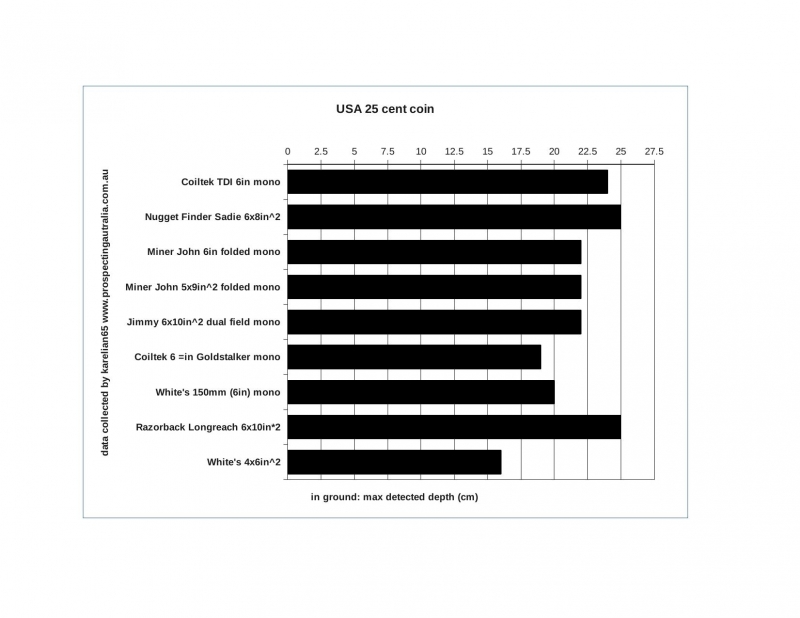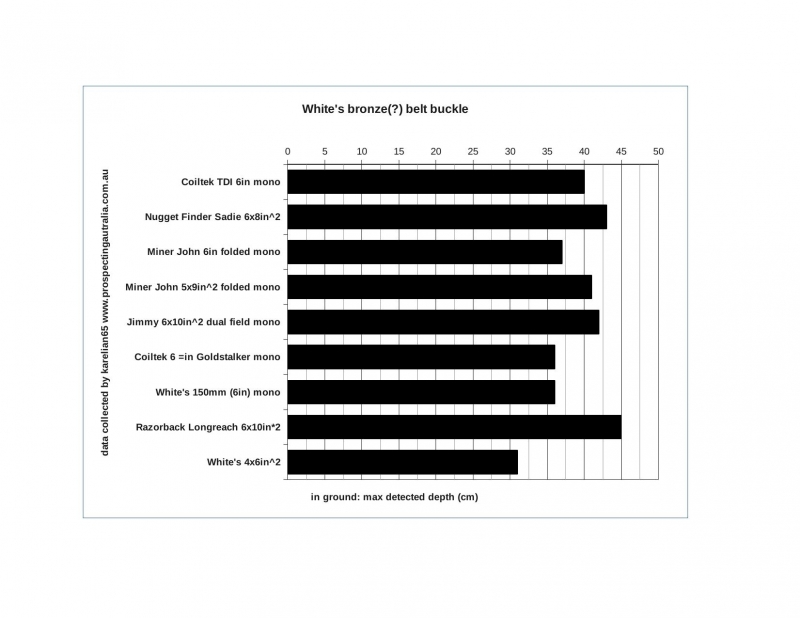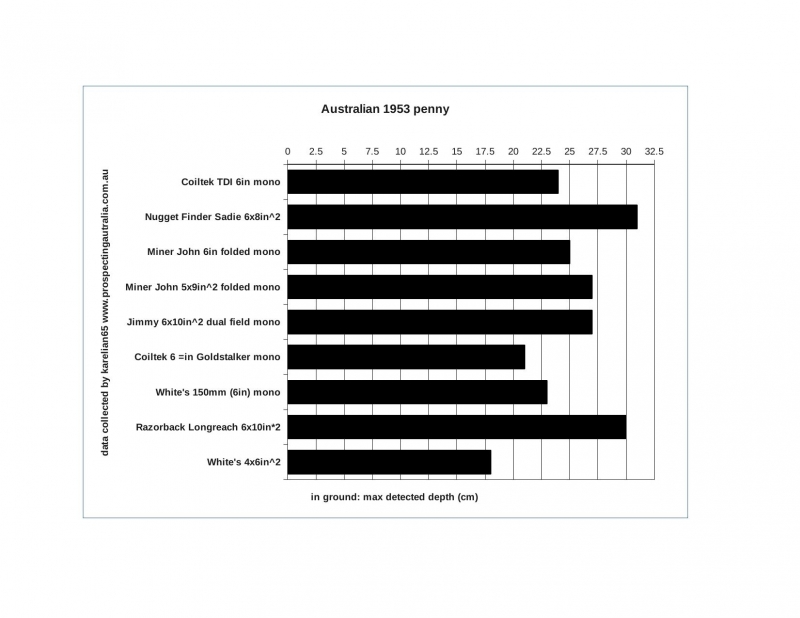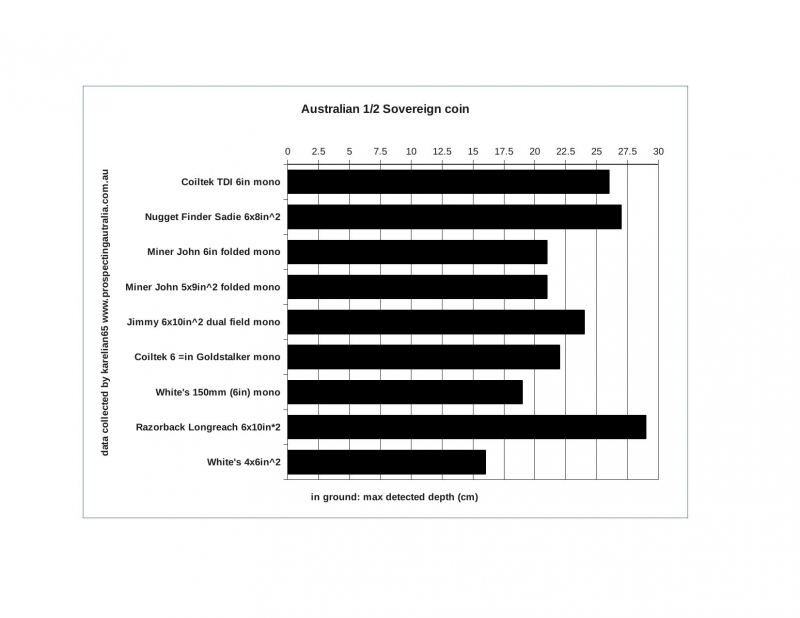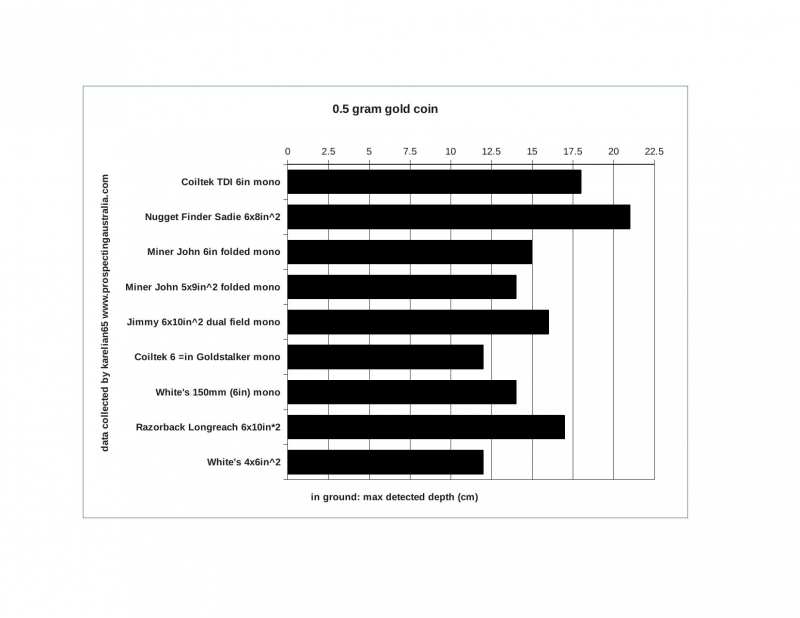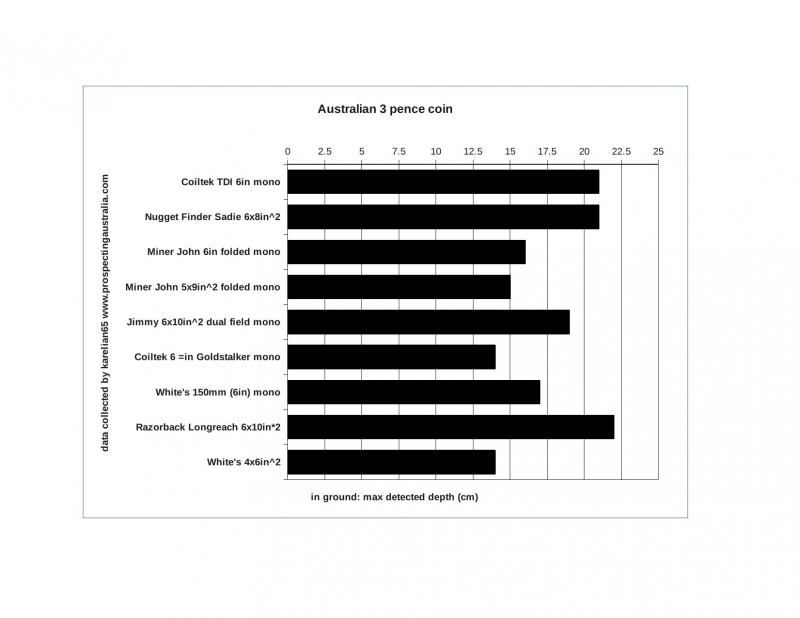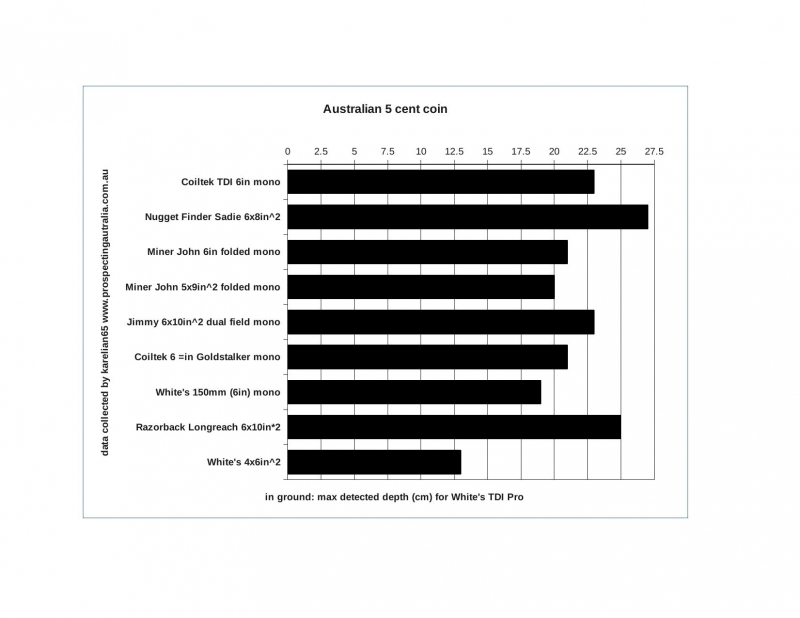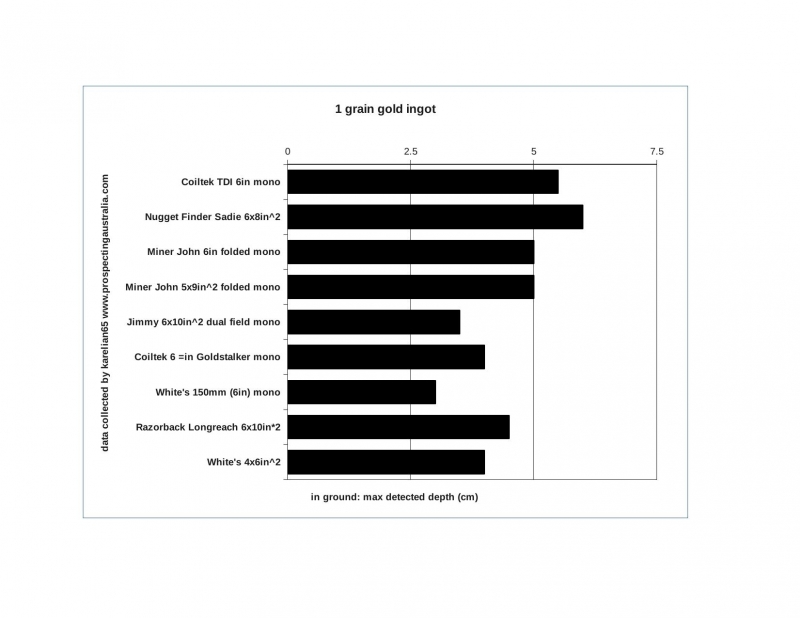-
Posts
5,804 -
Joined
-
Last visited
Content Type
Forums
Detector Prospector Home
Detector Database
Downloads
Everything posted by GB_Amateur
-

Why - Ferrous Tone While In All Metal?
GB_Amateur replied to Mark Gillespie's topic in Metal Detector Advice & Comparisons
Mark, a while back you said you were using the TDI/SL in cinder-loaded ground and had to run the delay up to 16 us. You'd trade that capability for a VLF? (Or do you have more than one TDI?) I have both TDI/SPP and XTerra 705 and both are good detectors but one is a dog and the other a cat! They can't be compared, IMO. On top of that, although I haven't used the prospecting side of the XTerra much at all, the reason is that it is very different than the discriminator side. The Fisher Gold Bug Pro has two sides but they are a lot more alike -- sister and brother -- than the two sides of the XTerra. At least that is my experience. Can you at least try out the XTerra and see if it handles your ground before you give up something that apparently works in that environment? -

Minelab And Customer Communications
GB_Amateur replied to Steve Herschbach's topic in Minelab Metal Detectors
Of course you are right. The reality is some companies can't afford to set up their own service centers around the globe, and asking customers to send products overseas for repair would likely be a nightmare. If I were in Nokta/Makro's shoes (or Minelab's for that matter), what would I do? They apparently don't have a lot of options in the US, maybe only one.... I'm with a lot of you -- wanting Nok/Mak to succeed, not only because they are a company that makes products I use, but particularly because they have been so enthusiastic in a) listening to customers, and b) cranking out products (quickly!) that fit the customers' needs. Oh, and there's that 'communication' issue discussed in this thread that they appear to be pretty darn good at. So if my comments can be interpreted to be a diss of them, I made a mistake and apologize. Reality is that in some ways the US companies (e.g. Whites, First Texas, Garrett) have an advantage when it comes to servicing detectors owned by US customers. That makes it more likely their products will be bought here than from non-US competition, if all other things (especially performance of the actual devices) were equal. I suppose they have similar problems/challenges when it comes to servicing their products sold in other countries, too. -

Minelab And Customer Communications
GB_Amateur replied to Steve Herschbach's topic in Minelab Metal Detectors
That has been my concern about Nok/Mak from early on -- if you have a problem (in the US) with your detector you have to deal with a whale of a company (Kellyco) that, among other things, sells Long Range Locators (LRL's). The latter points to 3 things: 1) LRL's work as advertised. 2) The company selling them is dishonest. 3) The company selling them is incompetent. Carl has $25,000 saying it isn't #1. Who's putting up the $ for #2 and #3? -
Does the TDI Pro model (AFAIK, currently out of production) fit the requirements? I know some people feel that just upping the battery voltage on the TDI/SL will deliver more sensitivity, but I wonder if that is enough to even bring it up to the level of the TDI Pro.
-
Reviewing that thread you linked above, here is something you (Steve) said 23 months ago, regarding the rumored Fisher CZX: "We seriously need something that brings gold detector weights and prices back to earth and so hopefully this will be it." And we all here know that in the meantime there have been a few 'somethings' that fit this description, just not from First Texas.
-

See Through Glass, Made From Metal
GB_Amateur replied to Sourdough Scott's topic in Rocks, Minerals, Gems & Geology
Not meaning to nitpick, but although the title of the article calls it a metal, it's not. Here's a wikipedia article about the substance: https://en.wikipedia.org/wiki/Spinel Roughly it's analogous to fused silica (man made lenses, windows, etc.) relationship to natural quartz -- the same chemical composition but fabricated to tight specifications (especially minimizing impurities) compared to what nature does. -
That's why I continue to watch Gold Rush although it seems to get tougher every year. I occasionally learn something. I'd like to see the nice+intelligent people, but those are the ones who disappear. Mostly we're left with a bunch of jerks who treat their fellow workers like garbage. But apparently that is what the majority of the audience wants. The obnoxious, belligerent people on Bering Sea Gold were too much even for me. I'm sure there were/are some decent, smart people there, but the jerks were too over-the-top. If it weren't for Freddy Dodge (who seems to know what he's doing AND treats people with respect) I'd be done with Gold Rush, too.
-
While we're on the subject of LRL's, here's a good page (by Carl Moreland): http://www.geotech1.com/cgi-bin/pages/common/index.pl?page=lrl&file=main.dat and he puts his money where his mouth is: http://www.geotech1.com/cgi-bin/pages/common/index.pl?page=lrl&file=reward.dat When I first read this I thought "now this Carl is my kind of guy!" He's the Amazing Randi of the metal detecting world. https://en.wikipedia.org/wiki/One_Million_Dollar_Paranormal_Challenge
-
I watch a lot of these shows, but with a skeptical eye. This one I've been watching the repeat on Monday evening (6 days later) on the Science Channel, so I haven't seen episode 3 yet. The part about "long range detection" is rather murky. It possibly was some kind of gamma ray detector. But it's not obvious to me that Cooper used this to aid in his search. In fact, it wouldn't be of any use looking for treasure wrecks since they don't emit gamma rays, unlike nuclear fuel. To me young Miklos (to distinguish him from his father) is making too much of that. Maybe it sucks in the sensationalist searching viewers, but I don't see it has any meaning to finding treasure. In episode 2 he interviews a NASA communicator from Cooper's Mercury mission and completely blows it -- pissing the guy off with his questions about secret, military intelligence, etc. so much that he walks off in disgust. Scripted? Maybe not the interviewee (NASA guy) but I wouldn't be surprised if the show's producer is pushing this part. The jury is out for me, but I'm still watching. That's more than I can say for Bering Sea Gold, which (at least a couple years ago before I got disgusted) is at best a soap opera, and a bad one at that. Unfortunately there is a common theme among these shows, IMO. They can't get sufficient audience to just show reality so they go and try to stir up and display conflict, confrontation, etc. to pull in the unthinking masses.
-
I'm hoping these plots make it easier to digest all that good data from kerelian65. I've shown the axes gridlines in 2.5 cm divisions since that is very close to 1 inch.
-
How does the diameter of the Australian penny used in the test compare with an English penny? I'd like to see how my White's SuperPulse 220 mm (flying saucer) coil compares to those others in an air test. I don't think I have any Australian coins (but I need to look at my foreign coin stash to make sure). I have a souped up battery pack that will run at 14.4 V in my TDI/SPP so that may help get closer to apples-to-apples comparison with the TDI/Pro. UPDATE: found a 1943 Australian penny in my collection. When I find the English penny I can answer my own question, although now it's just a curiosity for me since I have a test coin.
-
I wonder what "24 bit signal processor" really means, and if it is actually new. The lead in to that bullet point in the ICMJ ad is "Faster Processor", but it doesn't say what it is faster than. Just because it has a 24 bit highway doesn't necessarily mean it's fast, although that's usually the reason for the bigger pipeline -- to get data in quickly so it can be processed quickly. Here is an excerpt from volume 4 of Fisher Research Labs World Treasure News (2013) in an article written by First Texas engineer Jorge Saad titled "The new Gold Bug History": In threshold mode the Gold Bug has its composite gain/threshold control on a single knob, just like the Omega. It has a unique variable discrimination tone break setting, pinpoint operation with approximate depth reading and retune capability, TID reading and signal strength bar graph. Speaking of TID, 13 bit A-to-D to 24 bit A-to-D made these routines much more powerful; it has been reported that the Gold Bug is noticeably more accurate than its predecessors IDing faint targets. It sounds like he's talking about the discriminator side with that 24 bit A/D converter, so I don't know if this is an apples to apples comparison or not. BTW, you can find this article on the Fisher website, but when I tried to download the .pdf to my browser it crashed so I wasn't able to link that here. But the parent link is: http://www.fisherlab.com/hobby/product-resources.htm
-

Bunch Of Nokta Impact Coin Digs Filmed
GB_Amateur replied to Steve Herschbach's topic in Nokta / Makro Metal Detectors
I suspect your second question is the key. There are probably a lot of parks with good masked coins just waiting for the right detector (and detectorist). He says somewhere (in video or in his response to comments) that this park hasn't been hunted, but I'm left wondering about that. I've felt that way, too, but just because you find stuff you think others should have found doesn't mean it's virgin. Discrimination is both a blessing and a curse, particularly in the wrong hands. And maybe this Impact is breaking new ground in regards to unmasking. I'm waiting for other reviews, but even at 4 lb (I swore I'd never buy a detector over 3), this one has moved to the top of my wish list. -
Side comment with some info I haven't seen here (but maybe just missed it): The F75 Black price has been reduced (see Ebay for example) so currently every one of First Texas flagships is discounted, and in an interesting $100 sequence -- F75 black @$799 T2 black @$699 F75 gold @$599 T2 green @$499 Teknetics Patriot (F70 clone?) @$399. The top two have the extra processes (Boost and Cache) and each of those additionally comes with an extra coil (5 in round DD) along with the stock 7x11 in^2 DD that all the above have standard.
-
Gee, thanks, guys (sarcasm). I've been working on an Excel spreadsheet detailing features/properties of detectors I'm considering for my next acquisition, with a list of candidates. It just got longer.... If it just had audio mixed mode to make Mark G. happy. Question (hope I'm not sounding like a broken record): Is the all-metal true, single filter (auto-tune, first derivative) or phony disc in sheep's clothing? (I looked in the manual but couldn't figure it out from the wording there.)
-

Bullet Identification?
GB_Amateur replied to Cabin Fever's topic in Metal Detecting For Coins & Relics
Hope you get an answer that tells us where to look (books &/ internet) for ID'ing bullets. I have one (not a mini-ball) that I found in Santa Cruz mountains in an area that was logged as early as the 1880's. But for all I know it was deposited there in the late 20th century. Seems like with all the interest in firearms there ought to be lots of places to find info on historical items, but I've drawn a blank. I'm amazed at how clean that V-nickel is. It seems when I pull modern Jeffs (same composition, I think) out of the ground it looks like they've been soaking in acid. Not just the color, but the overall relief (relative depth of features) is compromised. I've found clad coins in which the cupro-nickel coating is about gone and what you see (my conclusion) is just the copper core. I guess it might be something naturally in the soil, or the chemicals (fertilizers, herbicides, pesticides,...) that have been used. Oh, and that's a good looking (and condition) Indian Head -- can easily read 'LIBERTY' on the headband. -

What Was Your 1st Detector?
GB_Amateur replied to Sourdough Scott's topic in Metal Detector Advice & Comparisons
First detector (not bought) was one I built in summer of '69 before my junior year in high school -- from scratch based on a design in an electronics magazine. I wound the coil onto a plywood disc. The rod was literally a broom handle. I think it might have detected a manhole cover at 6 inches -- I did say "might have." A couple years ago I was cleaning out a cabinet and found the control box (still loaded) and stripped out the guts. Control box is shown in the pic below. Today whenever I think about noisy response, falsing, drift, EMI, etc. I just have to remind myself of the performance of that one! A year later I got smarter ("less dumb" is probably more descriptive) and bought and assembled a Heathkit GD-48. Put a diode in backward, and after little or no debugging, sent it to Michigan to get it repaired. Likely it took them all of about 15 seconds to troubleshoot. Found some Wheaties from the teens (probably 1919 and 1910, but didn't take good notes). My memory says 8 inches deep in mild soil (and ~100 kHz detector!) for one of those, but you know how fish stories increase in exaggeration with the passing of time (45+ years...). The Northern Indiana football field I found them in is still a municipal property and I have dreams of returning some day with a modern detector. Only silver was a WWII nickel (aka 'Warnick'). The scaffolding hammer head in the pic below was rusted and badly pitted when dug up at my parents' farmhouse, likely in the ground 30-35 years from when the house was built. My uncle wire brushed it and put a handle on it. My mom had it in her toolbox and I inherited in when she passed away. Yes, I use it. Brings back a lot of good memories of my mom and her brother. Picture has the broken GD-48 (the plastic in those was really bad -- seen some for sale on e-bay with broken control boxes). The coil is 10 inches. Note there is only one knob (sensitivity) -- a true turn-on-and-go detector! -
A lot of detectors let you notch out (silence) a target identification (TID) band but are there any that let you choose which tone (audio frequency) to assign to a band?
-
Thanks for that link, Steve. Here's a quote from that page, for those who didn't bother going and reading it, and especially for those who did: So next time you venture out just pretend your detector is a brand spanking new, knock your socks off, killer of a machine. Look at the controls and various settings as though you’ve never seen them before, experiment with them and go ever so slow. I'm going to do that... tomorrow.
-

Earbuds Instead Of Headphones
GB_Amateur replied to Jakepilot86's topic in Metal Detector Advice & Comparisons
Made it to the (ancient glacier) gold bearing creek this afternoon -- only 2 hours with the detector on with another 1.5 hours scouting and hiking to/from the detecting spot. I went with the White's TDI/SPP and 150 mm (6 inch) modified round mono coil. (Mods are 2-part: added weight to make it neutral buoyant and replaced bottom half of coil housing to get coil closer to the ground.) The Bose earbuds worked well, but I don't think they are as good for gold hunting where you need to be sensitive to very small changes in threshold. For the most part, coin hunting and running in discriminator mode (with VLF's), you work in silent mode (with exceptions, of course) so background noise isn't as much of an issue finding targets. I was in a pretty quiet spot with respect to human activity (e.g. traffic noise) and the creek was down due to our rather dry spring weather. But even the low to moderate noise from water flow was noticeable and distracting when trying to hear threshold wobble. I'm not implying that anyone said these should be used for gold hunting. My experience is just one datapoint of observation. And sometimes perfect hearing isn't the right path. If it's >40C (>~100F) I can imagine the discomfort of over-ear headphones can be more distracting and debilitating than a bit of extra background noise. The TDI/SPP worked like a trooper, which is unfortunately more than I can say for the Garrett Propointer AT (aka "carrot"). I think I've worn out the rubber cup that protects the on/off switch. Pretty sure water got inside the unit. So far it hasn't recovered after getting home and blowing it out with dry canned air.... Maybe $130 expense every couple years is just part of the game. -

Earbuds Instead Of Headphones
GB_Amateur replied to Jakepilot86's topic in Metal Detector Advice & Comparisons
Pair arrived Friday, just in time for the weekend hunting. Got in about 3 1/2 hours yesterday in a park which is right across from a hospital and along a busy street. A girl was playing guitar and bellowing folk lyrics, kids were playing on the jungle gym, and police cars with sirens blaring occasionally roared past (but not helicopters today -- good news in the trauma unit). A basketball player stopped to ask me what I had found (I don't mind that -- good P.R. AFAIC) and I easily carried on a conversation with him. So, first observation: you can easily hear surrounding sounds. Now I thought that would be bad, but with the speakers so close to the ear canal I could hear signals (and background noise) quite well. (Maybe I'm understanding why people like the Sennheiser HD 598's -- a topic on another thread.) Even with some over-ear headphones (I have Garrett Master Sounds and Koss UR-30's) the noise from sirens and mufflerless pickups (got a lot of those here) get very annoying, but surprisingly the earbuds squelched that annoyance. I tried these out on my desktop computer, listening to YouTube music videos and they sounded about as good as my Sony on-ear music headphones. However, connected to my Fisher Gold Bug Pro they seemed rather 'tinny'. I got used to that. Will be interesting to see how they sound on the Minelab X-Terra 705 in 99 tones mode. Best thing about these is how lightweight they are -- not surprising, but not having the extra bulkiness of standard headphones is nice. And when it gets hot this summer... I did notice the wires rubbing against and tickling my face and neck. I was using the Deteknix Wireless Transmitter/Receiver. The wire leads (earbuds to 3.5 mm connector) don't seem very long -- great for wireless but I wonder if they would even be usable plugged directly into a detector. Also the connector is straight, not 90 degree angled so with some detectors that would be vulnerable to getting damaged. I need some more time with these (hope to make it out today) to really get settled in with them. I can imagine there are times when I would prefer high-end detector headphones (like the Sun Ray Pro Golds -- those are on my Christmas list ), to block out 95% or more of background noise. But even in my noisy parks I've found the Bose Soundsport In-ear Headphones (earbuds) quite effective. -
I took my trusty Fisher Gold Bug Pro to my favorite park just this afternoon, with the 5x10 in^2 DD (12.7 cm X 25.4cm) coil. Over the past 8 months I've been going back and forth between the GB-Pro and the Minelab X-Terra 705. Objectively (the way I like to stay) they are both excellent detectors. I currently have five coils for the GB-Pro and four coils for the X-T705. I also tried out my new Bose earbuds for the first time today. (More on that in the appropriate thread.) Last night and this morning I decide to reread the operations manual for the GB-Pro, and I'm glad I did. As simple of a detector as it is, and as well written and concise the manual is, there were several things I hadn't appreciated in previous readings, and I'm sure I've read it at least times prior to last night. I mostly use small coils with all my detectors. The parks I hunt are loaded with iron, because 1) they were either industrial or agricultural sites prior to becoming parks, and 2) they really haven't seen a lot of detectoring (I know that is surprising, but based upon the finds I've made, I'm pretty sure it is true). The 5X10 DD is intermediate between the 5 in round DD and the 7X11 in^2 elliptical DD that you discuss. It is a good compromise in terms of coverage (covers more ground but not so much that it is swamped by the iron). However, it is not very good at distinguishing bottle caps (the old kind -- made of steel) from coins. Both read in the low- to mid-80's on the VID scale. The smaller coils (e.g. 5 in. diameter Fisher stock) do a better job at that. Of course for gold prospecting you are going to dig everything in the non-ferrous range and even some in the ferrous, so the 5X10 coil does great for that application. For coin hunting where discrimination can be key, it falls a bit short compared to the smaller coils. I gotta say I'm a zealot when it comes to weight. With the exception of the XP Deus (and maybe a few others) the GB family (and that includes the Tek G2's) is as light as it gets. And it's pretty well balanced to boot, over the spectrum of available coils. It is simple to set up and run, but don't translate that into sub-par in performance. It hits hard on small targets and goes deep (in all-metal). Simple doesn't mean substandard, and the GB proves it. Ironically, Fisher has downplayed the GB's coin hunting ability. I'm pretty sure (and this is based on First Texas engineer Jorge Saad's article) that they were afraid they would turn off prospectors if they tried to sell it as a coin machine when it was designed as a gold machine. As evidence, look at the Fisher F19 (Tek G2+) which is basically the same detector with a couple more bells and whistles. They market it as relic/coin detector, and for good reason. But it's just the Gold Bug in sheep's clothing! Yes, the GB is designed for prospecting, but for a 19 kHz detector, it's a pretty damned good all-purpose detector, too. Tomorrow I'm going to "gold country" (what we in the Midwest have for that, which is the weak second/third cousin to what you fortunate Western North Americans and Australians enjoy). I'll take both my GB-Pro (with the 5 in coil) and my White's TDI/SPP (with the Miner John 5x9 in^2 folded mono plus my modified 150mm neutral buoyant mono) and see what sounds I can generate. It's probably a long shot, but I'm not discouraged by firing blanks -- if I were I'd have quit this hobby long ago. To quote a cliche' used in many pursuits: "the next best thing to hunting and finding gold, is hunting and not finding any."
-

How Long To Swing A Coil Over One Acre?
GB_Amateur replied to hawkeye's topic in Detector Prospector Forum
Another sort-of datapoint: Many coin/treasure (not nugget) hunting clubs have organized park hunts where they plant tokens/coins and redeem them for prizes. Although I've never been on one, I think they get a few hours to cover a few acres, and searched dozens of detectorists. By the end, there are still planted targets that haven't been returned. My sister's club used to plant valuable items but did away with that and now plant worthless tokens which are redeemed for the valuables -- that way the club at least doesn't 'waste' any good stuff.


